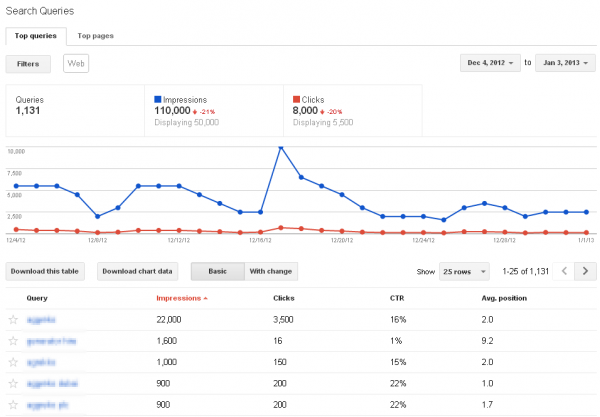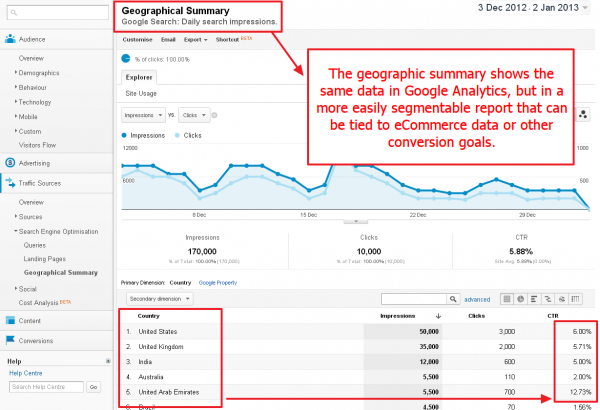Reporting Multinational SEO Performance: Difficulties & Insights
Whether you report on just two or twenty different regions, getting a centralised report on search engine result page performance by region can be a headache if you don’t have an easy — and scalable — reporting system in place. There are lots of ways to tackle the problem, but by far the easiest is […]
Whether you report on just two or twenty different regions, getting a centralised report on search engine result page performance by region can be a headache if you don’t have an easy — and scalable — reporting system in place.
There are lots of ways to tackle the problem, but by far the easiest is via Google’s Webmaster Tools, now integrated into Google Analytics, which has the added advantage of being free, always a benefit to those working within tight budgets.
Interestingly, looking at alternatives to see what the paid competition offers results in very little opportunity. Truly multinational SEO tools are thin on the ground — and those that do offer multinational SEO reports as a feature invariably have a critical failing: they don’t search from the reporting country.
The majority simply try to replicate multinational SERPs by selecting the local TLD version of the search engine queried; an obvious failing for the likes of Google, which serves dramatically different SERPs to different IP locations.
Many other ranking tools hop onto a CDN to gather results, which can be effective for a limited set of countries, but falls over for any country without an exit node. Also, there’s an obvious problem with using CDNs or other cloud-based solutions (like Amazon’s EC2) — the exit IP ranges are well known; therefore provide poor IPs to get a neutral understanding of rankings for key phrases for search engine’s alert to scraping tools (the only way to naturally gather rankings).
Data warehousing also rears its head at this stage, as tools that gather rankings for different countries via their own network of IPs and allow paid access to them force you to depend on their set key phrases. There are none that offer full access to run any key phrase in any country you select and return a truly local, untarnished ranking.
This kind of report is very valuable, as regardless of personalisation, the underlying ranking report shows the true performance of a page for a target key phrase, increasing its ability to significantly become part of the personalised SERP.
These reports are also critical to gain competitive intelligence on performing URLs and domains for target sets of key phrase terms that can allow for a range of strategic activity to improve your own SEO efforts such as gap-led SEO linkbuilding.
Google-Centric Solutions & Insights
So, we return to Google’s reports, showing impressions and clicks for your performing key phrases. How can we make this effective for multinational campaigns?
In the past, we used to have to segment our Webmaster Tools Verification into multiple, different locations to gain country-specific data in the very useful Impressions Vs. Clicks data of the Search Queries report.

Google Webmaster Tools’ Search Queries Report
Today, we only need that structure when geo-locating WMT accounts to specific countries (still important, though now also achievable using hreflang sitemaps), or if we have decided to use a multiple TLD approach to our international site architecture (something, I’d advise against).
That’s because Google has added the ability to segment the Search Queries report by country.

Google Search Queries Report’s Location Options
The only drawbacks to this data are: we are restricted by domains we control (so, no glorious competitive intelligence to be had here); and also, we can’t see beyond Google, which is very important in many countries where Google’s market share is comparatively weak (not least the US!).
Those caveats aside, when we view the same data within Google Analytics, our ability to segment data beyond the SERP into goal tracking and e-commerce returns gives us a very flexible, multinational SERP performance analysis tool that can be scheduled to deliver convenient reports at whatever frequency we like, for whichever regions we determine.

Google Analytics Geographic Summary for Search Engine Optimisation Report
Insights can quickly be derived for regions where SERP clickthrough has fallen dramatically, or overall impressions have dropped away. Critical region-specific landing pages can be identified quickly and scheduled for A/B testing should their conversion rates be sub-par, and so on.
With the lack of viable alternatives, Google’s Webmaster Tool Data is the best option out there for multinational webmasters, hindered only by a lack of competitive intelligence, which could be brought to bear for profitable competitor analysis.
Contributing authors are invited to create content for Search Engine Land and are chosen for their expertise and contribution to the search community. Our contributors work under the oversight of the editorial staff and contributions are checked for quality and relevance to our readers. The opinions they express are their own.
Related stories